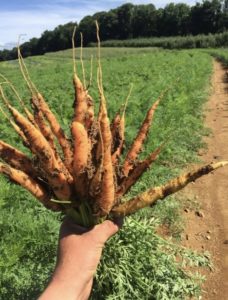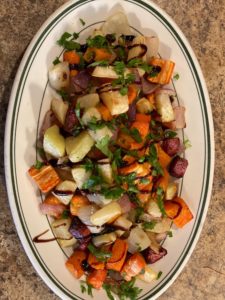Keep Calm and Carrot On
Keep Calm and Carrot On
Carrots and parsnips are cool-season, root veggies that we plant in early spring and fall. Carrots that have been planted in spring will be available typically from June through November and then longer with cold storage. Parsnips are available, typically, in April & May and then again in October through December. Root vegetables are low… Read More »

Root vegetables are low in calories, high in vitamins, minerals, and antioxidants, and are very nourishing, as you would expect. High in fiber and slow-burning carbs, root veggies may help boost gut health. Growing underground, root vegetables soak up all the nutrients the earth has to offer making them an important food staple for this time of year. Known for the nutrient-dense content they have sustained life during the cold harsh winters for many generations due to their easy and long storage capabilities and exceptional nutritional qualities.
Why do we call them root veggies? Vegetables are classified into categories defined by which part of the plant is eaten. For example, a bulb consists of onions, leeks, and garlic, whereas, stem veggies consist of asparagus & rhubarb. Fruit vegetables consist of cucumbers, peppers, tomatoes, pumpkins & melons. Seeds consist of peas & beans, flowering veggies consist of broccoli and cauliflower, while lastly, root vegetables (and tubers) consist of sweet potatoes, celery root, cassava, and Daikon radish.
Carrots and parsnips are related to parsley and celery, belonging to the Apiaceae, a flowering plant family. Both can be eaten raw along with prepared in a variety of ways. In fact, the entire plant is edible, as a sustainable farm we encourage you to consume both the tops and the bottoms so that nothing goes to waste. Miss Jenn, our culinary specialist, curated recipes on our website for using carrot greens including; soup, tea, and pesto. Carrots and parsnips are most known for their use in soups and stews, however, they are also so versatile in the culinary world. They can be air-fried, baked, boiled, braised, grilled, mashed, pressure-cooked, or roasted. They taste great made into hashes, slaws, soups, or gratins’ or hold up well made into quick fermented pickles. Toss into soups, salads, stir-fries, or sandwich wraps. Most root vegetables can be eaten both raw and cooked with the exception of potatoes. Read more about how to use the entire produce, tops, and bottoms, on our blog.
Traditionally, root vegetables were stored in a root cellar in earlier times. In today’s times, we recommend storing your carrots and parsnips unwashed in the refrigerator and loosely wrapped in plastic wrap for 2-3 weeks. Be sure to remove the tops first as they continue to take moisture from the roots.
Looking for recipes so that you can enjoy eating in season along with us on our farm? Check out these recipes to learn more; carrot citrus salad, orange honey glazed carrots, roasted root vegetable soup or an easy, one-pan roasted root veg dish.
We can’t wait to hear from you about how you enjoyed these recipes! Feel free to share your favorite recipes for carrots or parsnips with us. Drop us a line on our social media or email us info@alstedefarms.com
Best wishes from our farm kitchen to yours! XO








